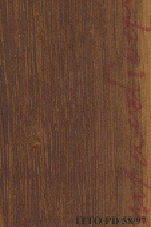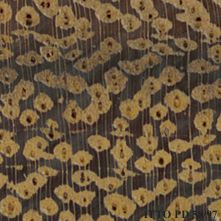
FAVEIRA AMARGOSA (Vatairea guianensis)
Trade Name
Faveira amargosa
Scientific Name
Vatairea guianensis Aubl.
Family
LEGUMINOSAE
Common Names
Geli Kabbes (Surinam); Geli-kabissi (Surinam); Amargo (Panama); Amargo (Honduras); Yongo (French Guiana); Inkassa (French Guiana); Arisauro (Guyana); Maqui (Colombia); Faveira Amargosa (Brazil); Fava Amargosa (Brazil); Angelim Amargoso (Brazil)
Scientific Name Synonyms
Vuacapua amazonum (Mart. ex Benth.) Kuntze; Vatairea surinamensis Kleinhoonte; Ormosia pacimonensis Spruce ex Benth.; Andira bracteosa Benth.; Andira amazonum Mart. ex Benth.
Description Of The Tree
Botanical Description
It is a medium size tree with heights of up to 20 m. The diameter at breast height is commonly 80 cm. The bole is straight, but slightly fluted. This species is reported to present buttresses, sometimes 1 m tall.
Natural Habitat
Vatairea guianensis is reported in temporary inundable areas in the Amazon basin. It is found varzea forests, igapós and along river banks and streams.
Natural Distribution
It is widely distributed all over the Amazon basin. In Peru it is found in the departments of Loreto, Ucayali and Madre de Dios.
Wood Identification
Anatomic Description Of Wood
Wood diffuse porous. Vessels solitary and in short radial multiples. Tangential diameter of vessel lumina 200 micras or more (large). Vessels per mm2 less than 6 (rare). Simple perforation plates. Vessel-ray pits similar to intervessel pits in size and shape. I Axial parenchyma apparent with the naked eye. Axial parenchyma lozenge-aliform. Axial parenchyma thick lozenge-aliform. Axial parenchyma confluent. Prismatic crystals in chambered axial parenchyma cells and/or in fibers. 3 to 4 cells per parenchyma strand. 4 to 10 rays per mm (medium). Rays 1 to 4 seriate. Homogeneous rays and/or sub-homogeneous rays (all ray cells procumbent). Fibers with simple to minutely bordered pits.
-
 Wood Macro Photo Tangential Plane
Wood Macro Photo Tangential Plane
-
 Wood Micro Photo Of Transversal Section
Wood Micro Photo Of Transversal Section
Availability
Cites Status
Unrestricted
General Wood Description
Odor
It is reported to have a characteristic odor.
Color
The pale brown sapwood is differentiated from the heartwood which is dark yellowish brown when dry.
COLOR INDEX (1=Black, 7=Light yellow,white)
2
Grain
The grain is straight or interlocked
Texture
The texture is mostly medium to coarse.
Luster
Luster is usually moderate.
Natural Durability
This species is reported to be moderately durable against decay and termites, but is rated as durable against dry wood insects.
Natural durability index (1= Very high durability, 7=Vey low durability)
3
Resistance To Impregnation
The heartwood is reported to be untreatable.
Wood Physical Properties
Basic Density or Specific Gravity (O.D. weight/vol. green) (g/cm³)
0.59
Air-dry Density (Weight and volume at 12%MC) (g/cm³)
0.65
Total shrinkage Tangential (Saturated to 0%MC) (%)
7.9
Total shrinkage Radial (Saturated to 0%MC) (%)
5.3
Drying Defects
Ease of Drying: It is rated as moderately difficult to season. Drying Defects: Boxed heart pieces tend to split. Kiln Schedules: Slow drying rates and careful stacking are recommended to reduce degrade.
Dimensional stability ratio (Total Tangential Shrinkage %/Total Radial Shrinkage %)
1.5
Wood Chemical Properties
Wood Mechanical Properties
Bending Strength (MOR),12%MC (kgf/cm²)
837
Stiffness (MOE) 12%MC (kgf/cm²)
103000
Compression parallel to fiber 12%MC (kgf/cm²)
489
Shear strength radial 12%MC (kgf/cm²)
139
Janka hardness (side) 12%MC (kgf)
633
Janka hardness (end grain) 12%MC (kgf)
635
Workability
Rotary Veneer Cutting
This species is reported to be interesting for decorative veneer.
Sliced Veneer
This species is reported to be interesting for decorative veneer.
Blunting Effect
Wood of this species exerts a moderate blunting effect on the cutting tools.
Machining
It is easy to machine.
Nailing
This species is reported to have a good nailing behavior.
Gluing
The timber is reported to glue well.
Finishing
Finishing of this species is reportedly easy.
REFERENCED USES
End Uses Summary
HOUSING GENERAL, beams, joists, boards, FURNITURE AND CABINETS, common furniture, PLYWOOD AND VENEER, Decorative veneer, TOOLS, tool handles, agricultural tools, PACKING, heavy packing, pallets
General Housing
- 10 - Silica in Timbers
Beams
- 11 - Prospect: The wood database
Joists
- 12 - Tropical timbers of the world. Part I-Tropical American Species
Boards
- 13 - Dry kiln schedules for commercial woods. Temperate and tropical. Section III. Latin American (Mexico, Central, and South America) Woods–Conventional Temperatures
Furniture Cabinets
- 21 - Tropical timbers of the world. Part III-Southeast Asian and Oceanian Species.
Furniture, Common
- 23 - Handbook of Hardwoods
Panels, Veneers
- 25 - Directory of Timber Trade Malaysia
Decorative veneer
- 28 - Ministry of Agriculture, Fisheries & Forest of Fiji
Tools
- 42 - Utilización Industrial de Nuevas Especies Forestales en el Perú.
Tool Handles
- 43 - Maderas de Bolivia (Características y Usos de 55 Maderas Tropicales)
Agricultural Tools
- 44 - Atlas of Peruvian Woods
Packing
- 45 - Recopilación y Análisis de Estudios Tecnológicos de Maderas Peruanas
Heavy Packing
- 47 - Arvores Brasileiras
Pallets
- 48 - The strength properties of timbers
Please Provide Information To View Producer Information